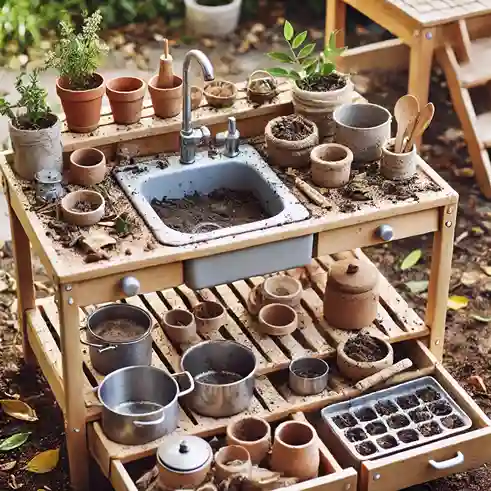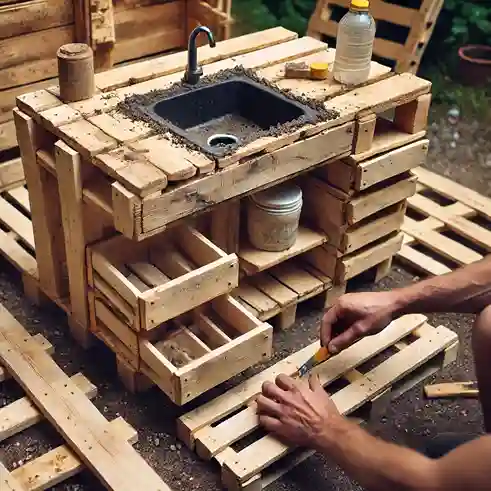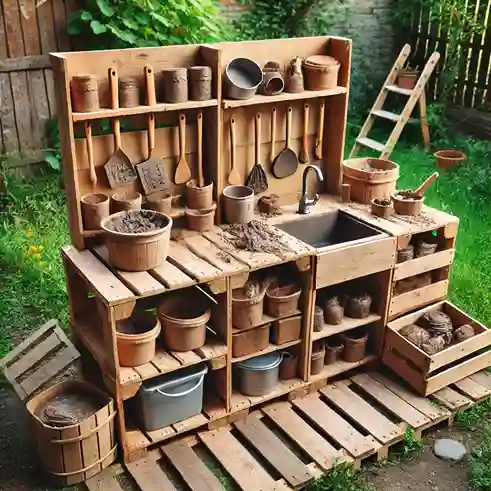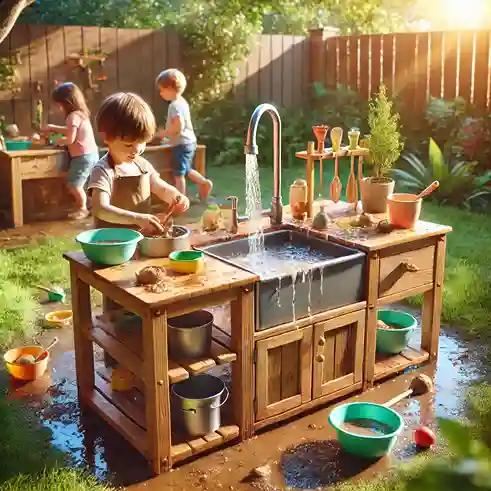Introduction to Mud Kitchen with Working Sink
Mud kitchens have become quite a fad in outdoor play spaces, especially for the young ones. These zones are meant for children’s imaginative and unstructured play and are therefore inscribed with a lot of sensory activities. In essence, mud kitchens are set up as outside workbenches containing a variety of items, utensils, and natural substances that allow children to pretend they are cooking while doing so in nature.
The specialty of a mud kitchen is the application in fostering creativity and imaginative role play. Children are attracted to dirt and water so a safer alternative can be offered for parents to allow dirtier construction sites where kids can learn by making mess. Also, a functional sink is even better, because kids can learn to clean, mix and just create things while having fun.
Outdoor play is vital for every child’s growing processes as it also consists a variety of skills. Resting in the mud and water creates the sense of touch which is key to thinking. Kids scoop dirt or dip their hands into water to feel the harshness of sand grains or the stark coldness of water which broadens their versatile sense of touch. Mud kitchens equally assist in developing social skills. Solo play activity and with friends has them involved with joint activity where they enact roles and learn how to interact and use language for cooperation.
In any backyard, a sink top mud kitchen is a nice add on which is enjoyed by kids outside as well. Living up the ethos of fondness for creation, it combines the spirit of adventure with the playful learning of growing up skills. Not only does this create a different level of outdoor fun for the children, but it also strengthens the children’s ties with nature, which in turn, improves their health and learning.
Advantages of Implementing a Functional Sink in a Mud Kitchen
Integrating a functional sink in a mud kitchen with working sink has numerous functional and educational advantages which will allow children to have more fun while playing outside. Probably, the biggest one is getting real life education. Kids are learning when a sink is used, for instance, they can use certain techniques when using the sink to cut and break certain things. This kind of play completely grasps the children’s attention while nurturing their interest in learning new things.
One of the major benefits is cleanliness. The children are encouraged to wash hands after playing with mud thanks to the sink present. This approach teaches them the importance of personal hygiene in a more interactive and fun way. This serves to develop responsibility with regard to personal hygiene as it plays an important role in health. Furthermore, being able to wash off after messy play puts the minds of parents, their caregivers at ease enabling children to use their imagination without favorable concerns.
Moreover, playable sinks allow for different types of pretend games, and joint work to be performed. It becomes a centerpiece of fantastic situations where children are allowed to fill the containers, pour in the water and mix different things in an organized sequence. This increases social interaction, sharing, team work and communication skills within the context of combined play activities.
Again, the presence of a sink will facilitate more practical work. When there is water, children tend to engage in more activities like mixing mud and water, which helps them to see what their mixtures feel like. A sink in the mud kitchen with working sink literally turns the play area into a classroom where children are taught through doing and experiencing. This holistic mode of learning during play is very important in enhancing the children’s imagination, skills in working with others as well as logical thinking skills while having fun in the natural environment.
Designing Your Mud Kitchen: Key Features to Consider

Providing an out-door play environment for children where they can experience the benefits of a boundless, creative and friendly environment is vital while creating a mud kitchen with working sink. Some of the first aspects to consider are the countertop’s height. mud kitchen with working sink are meant to be used by children of many ages although it would probably be best suited for those of the youngest ages. So in most cases, 24 to 30 inches can be more or less appropriate, adjustable heights would provide greater flexibility. However, children of older ages can also make use of older ones.
The mud kitchen with working sink therefore gives the designer the opportunity to select and source different materials as required for specific applications. Give yourself the promise that the materials you choose are resistant to a lot of factors and do not break easily as well as looking appealing to the eye. One such approach could be to use some types of wood like cedar or redwood which are more resistant to various factors such as moisture. Metal elements can also enhance the durability of the mud pits however they should not be sharp. Ensuring that the kitchen is safe for the children would mean that non-toxic paints and varnishes would be required.
In addition, the position of the elements of the mud kitchen with working sink is very critical in appealing and making it functional. A correctly done plan model should enable storage, ordering, and picking up of tools, pots and even play items with ease. Built-in cupboards, protruding basins for mixing and making things, and utensils hooks would equally help to stimulate children’s interests. As for the themes, there are endless ones, it comes down to personal preference, some would prefer something traditional that incorporates raw wood and stone to create a warm feel while some would prefer contemporary to incorporate pale colors and geometric forms to encourage thinking outside the box. At the same time, the goal should be to design a mud kitchen with working sink that is fancy, functional and fun to play with outdoors while ensuring that it’s child-appropriate.
Constructing the Structure: Tools and Materials Needed

If you plan to make a sink that is reasonably useful then remember that certain materials and tools must be picked with care as soggy and soggy children’s toys tend to be unsafe and unpleasant. Firstly, think of easy and cheap alternatives. Starting with building the main frames of the mud kitchen with working sink, reclaimed wood from pallets or old furniture make an ideal substitute. Its sustainable and usually cheap which is why it’s a favorite for DIY projects.
For the sink, you can either go with a stainless steel basin or a plastic tub as they are cheap and weather resistant. Try to source the fixtures from construction sites or lofts and other places if possible so as to reuse them and save on costs. When choosing the materials, make sure that they are free from obnoxious chemicals and treatments because the safety of children should come first. Do not use pressure treated woods which might be infused with poisonous chemicals instead use naturally rot resistant wood like cedar or untreated pine.
In respect of construction tools, without the correct tools it would be hard to succeed in the build. Most of the constructions should not be too complicated so a saw, hammers, drills and screws should be enough. You should also consider having sandpaper for smoothing wood corners, as well as a level to ensure the stability of your structure. Children can be strange, and sometimes using tools for young kids can be helpful. They make good tools for older kids as well and introduce them to DIY activities in a controlled manner.
Material selection and tools play a crucial role in ensuring that children will be able to engage themselves with outdoor play without any safety threats caused by the parent’s concern. The right shape of the mud kitchen with working sink is only a part of the solution, after all there are goals of instilling proper the culture and learning. Keep in mind that the main aim is to provide an engaging room where children can safely enjoy themselves while interacting with nature.
Completing the Steps to Adding a Working Sink

For countless children, an outdoor mud kitchen with working sink may be taken to another level with the addition of a working sink, giving children yet another purposed space to create and explore with their hands. However, it is prudent to begin with the basics, such as the plumbing concept. Installing a sink means having a water supply that could be in the form of a hose or portable tank, it however is an easier solution rather than the usual setup. The conventional plumbing set up is however more complicated and requires more advanced plans. Collect important materials such as drainage systems, pipe fittings and plumbing glue to ensure that the construction is safe and usable.
The second crucial step is to find Out a sink. In many cases, the families decide to utilize a former kitchen sink which are relatively inexpensive and easily available at second-hand stores or online sources. In addition, there is also an option of buying a new and small sink made for outdoor purpose. When choosing a sink, make sure it is made of heavy-duty materials that can withstand outdoor conditions, like stainless steel or composites.
After you have acquired the sink the next step would be installation. The first step is to identify the location of the sink within the outdoor mud kitchen with working sink. Water and drainage system should be within the zone selected for the sink. For some simpler arrangements, it may be enough to secure the sink on a robust wood construction and connecting a garden hose with her. For more permanent actions, simple plumbing must be observed in order to be effective and easy to install.
Your videos may be lacking a bit of professionalism, as they really need the finish of a proper construction piece. It is also likely that you have not spiced them up with a narration or voice-over. Some mud kitchen with working sink problems, such as surface loosening or lack of adequate pressure to water supply, can also be encountered during the fixing part. To specifically address this, Yarrows advises to do a thorough check-up on all the hoses and water supply pipes to see if everything is functional. This ease of setup allows children to enjoy the mud kitchen with working sink without complex plumbing however, use of a large bucket or a regular hand pump would still be needed. This procedure creates an even greater thrill of engaging in an activity while lessening the hassle of setting it up.
Adding an observer’s perspective, any cubby comes with key accessories that should be put together with a mud cubby, here are some them that enhance the experience.
The first problem every child has while constructing a proper cubby is lack of utensils, or small essentials; the additions of these tools can even include utensils such as pans, pots and sinks; the latter along with many essentials can be bought from thrift stores. This can promote and even allow children to fulfill their imagination by getting their hands dirty with mud, leaves and water.
In addition, adding river stones, branches and leaves complements the outdoor play setup of a mud kitchen with working sink. Young children can place stones around their kitchen as artifacts or build structures using them. Leaves can be placed around the kitchen as bowls while twigs can be used to enhance realism when children are ‘cooking,’ as they can pretend to use them as stirrers. Such a connection to the natural environment encourages children to use their sense of sight and moves them to explore.
For DIY enthusiasts, how about allowing kids to make their own props? Easy crafts that come handy include painting stones that can be served as kitchen pretend food or collecting different varieties of leaves for decoration purposes. Even creating tiny garden markers out of repurposed wood is a way to contribute. To make the experience feel more realistic, one can make ‘spice containers’ with jars filled with sand or gravel.
In short, the rumbling, tussling and getting dirty in a mud kitchen with working sink is made even better with creative elements and natural materials allowing the children to get indulge into imaginative play. These accessories not only make children creative but also let their imagination fly while getting the satisfaction of playing outside in the open.
Safety Precautions and Care of Your Mud Kitchen
Getting children to play pretend with a mud kitchen with working sink gets their creative juices flowing but safety of the child has to come first. For a mud kitchen with working sink, the most important safety tip is to be on watch. Children should be watched either by their parents or an older sibling whenever they are at the mud kitchen with working sink especially when they are using water. This will help divert any accidents that may happen as a result of children using non-edible play things and tools or if there are other children involved. It is also useful to set the limits for children to avoid any dangers while playing.
As far as the mud kitchen with working sink is concerned, it is critical to use durable and non-toxic materials avoiding rot optimally. It is preferable that wood used for construction of mud kitchen with working sink does not rot, and the paint is non-toxic and can be applied outside. Always check for any parts getting splintered or damaged, and any such unsafe parts should be mended or replaced immediately. Also, the use of blunt items belonging to older children would have to be locked away with the play being less messy for younger children.
In the same vein, cleanliness with regards to the mud kitchen with working sink has to be enforced. Regular maintenance of the kitchen would include the cleaning of the sink and mopping of mud and bacteria by applying soap to warm water. For the multitude of kitchen appliances which are made of plastic soaking them in vinegar and water would serve as a good disinfectant, while wooden pieces can be cleaned with wet rags and air dried. In addition to increasing the longevity of the mud kitchen with working sink, the sink and its facilities should be protected from exposure to conditions that are likely to cause crack or leak.
Before engaging in creative play, let all the development articles like sand, dirt and water be constantly changed. Not only will this help the young children’s environment to be active but the overall fun and safety of the mud kitchen with working sink will increase. And with these maintenance and safety strategies, it becomes possible for parents to make the place where children engage in mud play both fun and safe.
Encouraging Ideas for the Activities of Your Children in the Mud Kitchen.
A mud kitchen with working sink offers a great opportunity for children to dress up and role play as well as create a great learning experience. This space outdoors has so much potential to help children to be creative and work together. Here are some inspiring activity ideas that can be incorporated into your mud kitchen with working sink experience.
The first one that comes to mind is making mud pies. ‘There’ll be tons of dirt, and only water is needed’, is what the kids would say. This is where mud mixing magic comes in. They can mix dirt with water and make mud and the fun begins. Children can use molds and fill them with whatever they like including pots, pans and even their mothers’ kitchen tools. Children would love it if you inspire them to decorate their mud pies by layering them with leaves, flowers or stones adding an artistic design and creating a feeling of talking with different textures.
Additionally, another fun activity that children can enjoy is that of brewing herbal potions. Arrange a small cupboard with herbs, flowers and water. Children can then mix and combine these in many ways and talk about the wonderful things they’ve created as they do so. This enables children to get acquainted with various plants and their characteristics but also helps children develop language skills as they talk about their creations.
Children can even use the kitchen sink to carry out all the water experiments in a mud kitchen with working sink. Children can use a working sink to understand the meaning of volume, capacity and flow. They can pour different sized containers into each other and measure which promotes their mathematical skills counting the volume of water required to fill a particular container including spilling one.
Themed play scenarios can expand the scope of activities. For example, gals may pretend to have a flag at the top of the tower and serve mud food to their fellow classmates who are at the bottom. This role play easily enhances teamwork, role play and social skills among children. In addition, adding narrative helps children describe the kitchen activities they performed during their time in a mud kitchen with working sink.
In so many ways, these activities demonstrate the concepts of interactive play around a mud kitchen with working sink. Through every experience, creativity, social skills, and connection with nature are reinforced such that enjoyment is coupled with learning that is outdoor fun all the time.
Conclusion:
The Lasting Impact of Outdoor Play on children Outdoor environment plays an important part in the growth and development of children and benefits them in way that goes beyond physical benefits. Activities such as cooking in a mud kitchen with working sink provide children with a lot of different sensory experiences that promote creativity and imaginative adventures. Young children’s interest in the natural world is nurtured and hand skills developed when they are provided with a mud kitchen with working sink that has a functioning tap. The water and mud allow the children to play and explore. This type of activity encourages curiosity and investigation which are fundamental to development of thinking skills.
Outdoor activities are crucial in the development of children’s problem-solving and interpersonal skills. Whether they are preparing for cooking by mixing mud and water or building something out of natural materials with other kids, they are developing their social skills and emotional intelligence. Such active experiences not only enhance their creativity but also help them build autonomy and self-esteem while enabling them to take risks in an outdoor environment.
Also, establishing dedicated areas for outside play like mud kitchen with working sink creates lasting impressions in children. These interactions and cooperative activities foster children’s interactions with nature which has positive impacts on their emotional health. While socializing at play, they can experience different sensations and develop environmental appreciation. The excitement of pouring water, blending, and feeling different textures allows them to use their senses, hence improving their developmental experience.
Amateur parents and caregivers may facilitates the growth of their child through assisting him in engaging in outdoor freely through a mud kitchen with working sink. By providing such places we nurture the passion for art and the desire to play. In the end, outdoor activities are not just an addition to a child’s daily routine, they are an inseparable component of a person’s development and appreciation for the reality surrounding all of us.

